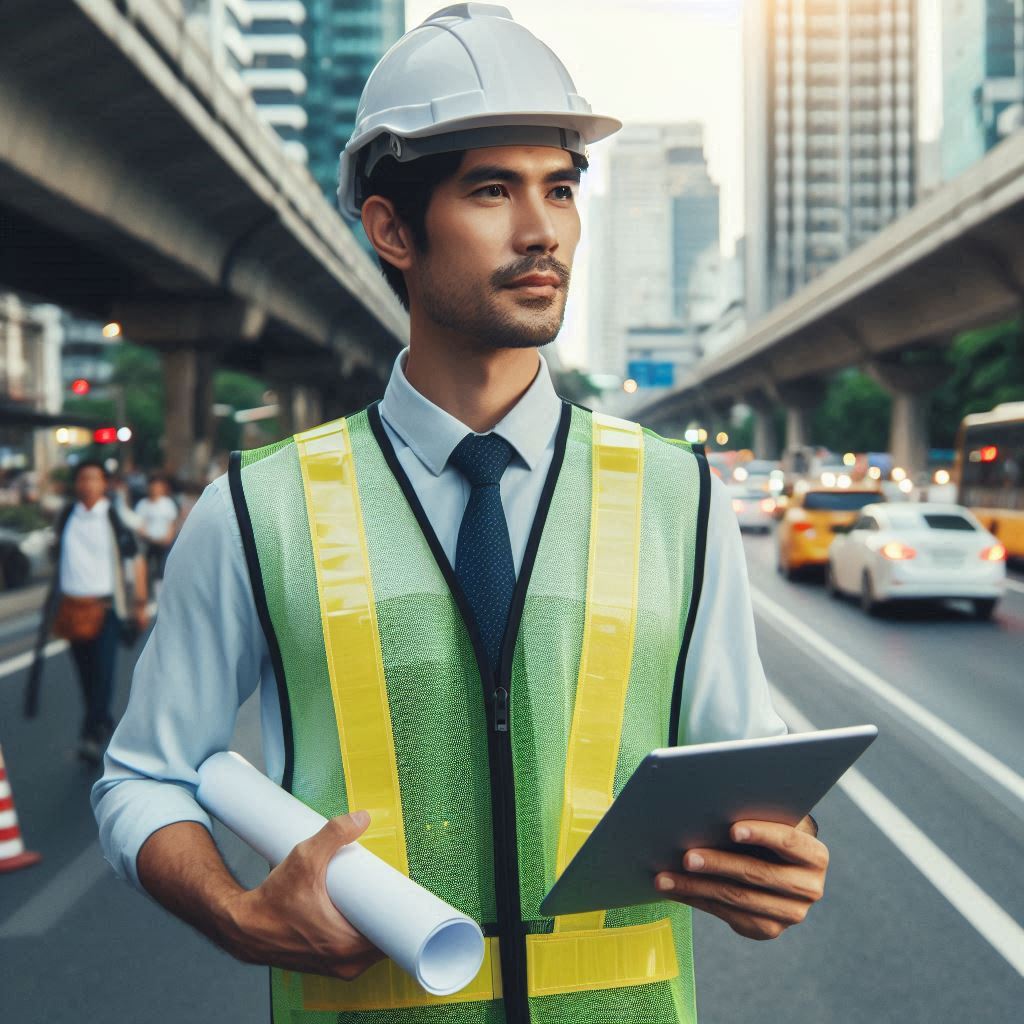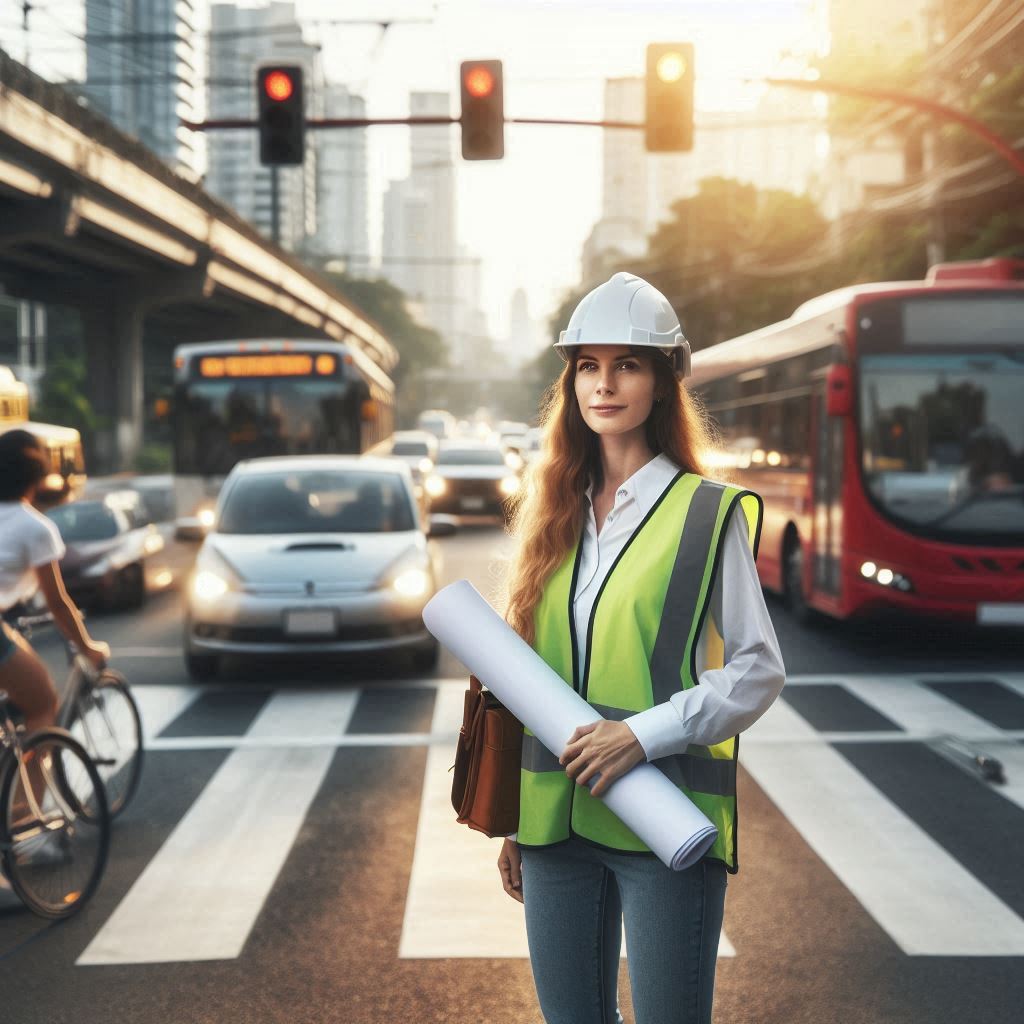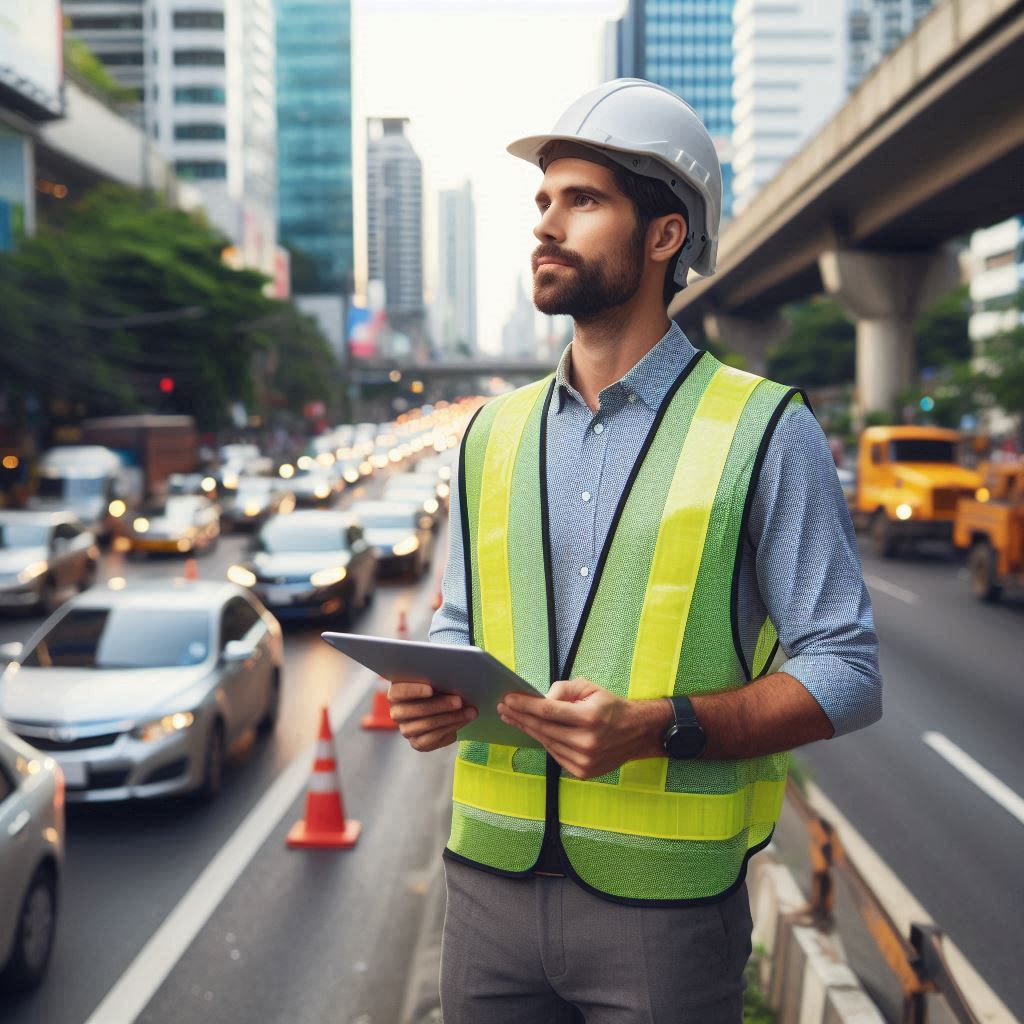Introduction
Transportation engineers play a crucial role in infrastructure development.
They design, build, and maintain transportation systems.
Their work ensures that roads, bridges, and railways meet safety and efficiency standards.
By addressing complex engineering challenges, transportation engineers facilitate the smooth movement of people and goods.
Their expertise is vital for creating reliable and sustainable transportation networks.
Briefly Introduce the Role of Transportation Engineers in Infrastructure Development
Transportation engineers are responsible for planning and executing projects that improve transportation infrastructure.
They work on a variety of projects, from highways and bridges to public transit systems.
Their tasks include analyzing traffic patterns, designing road layouts, and ensuring that construction meets regulatory standards.
Engineers also collaborate with urban planners to integrate transportation systems into community development plans.
By focusing on safety, efficiency, and environmental impact, they help create infrastructure that supports modern needs.
The Importance of Transportation Systems in Connecting Communities and Facilitating Economic Growth
Transportation systems are essential for connecting communities and driving economic growth.
Efficient transportation networks enable people to commute easily, reducing travel time and increasing productivity.
They also support the movement of goods, which is crucial for businesses to operate effectively.
Well-designed transportation infrastructure helps attract investments and promotes regional development.
By linking urban and rural areas, transportation systems ensure that all communities have access to essential services and opportunities.
Improved infrastructure leads to better quality of life and economic prosperity for everyone.
Transportation engineers, through their expertise, ensure that these systems are built to last.
They incorporate advanced technologies and sustainable practices into their designs.
This approach helps address future demands and environmental concerns.
In summary, the role of transportation engineers is fundamental to developing infrastructure that connects communities and drives economic growth.
Their contributions create a foundation for a thriving and interconnected society.
What transportation engineers do
Responsibilities of Transportation Engineers in Planning, Designing, and Implementing Transportation Systems
Transportation engineers play a vital role in shaping how we move.
They focus on planning, designing, and implementing transportation systems.
These professionals ensure that roads, bridges, and public transit systems meet the needs of communities.
They evaluate traffic patterns, population growth, and future transportation demands.
In planning, transportation engineers determine the best routes for roads and transit systems.
They consider factors like land use, environmental impact, and community needs.
Their goal is to create systems that are safe, efficient, and sustainable.
They also assess potential challenges, such as congestion and pollution, and plan solutions to address them.
Designing transportation systems requires attention to detail.
Transportation engineers develop detailed plans for roads, highways, bridges, and transit networks.
They ensure that designs meet safety standards and are built to last.
Their designs must also accommodate current and future traffic volumes.
Engineers use advanced software and modeling tools to create effective designs.
These tools help them visualize how transportation systems will function in real-world scenarios.
Implementation is where transportation engineers turn their plans into reality.
They oversee the construction of transportation projects, ensuring they are built correctly and on time.
Engineers work closely with contractors, government agencies, and other stakeholders to ensure projects meet all requirements.
They also monitor construction sites to address any issues that arise during the building process.
Role of Transportation Engineers in Improving Safety, Efficiency, and Sustainability of Transportation Infrastructure
Safety is a top priority for transportation engineers.
They design systems that minimize the risk of accidents and injuries.
Engineers incorporate features like traffic signals, signs, and barriers to enhance safety.
They also consider the needs of pedestrians, cyclists, and people with disabilities.
By designing safer systems, engineers help reduce the number of traffic-related injuries and fatalities.
Efficiency is another key focus for transportation engineers.
They aim to reduce travel times and improve traffic flow.
Engineers analyze traffic patterns to identify and address bottlenecks.
They design roads and highways that can handle high volumes of traffic without causing delays.
Public transit systems are also designed to be efficient, providing reliable and timely service to commuters.
Sustainability is increasingly important in transportation engineering.
Engineers work to minimize the environmental impact of transportation systems.
They design systems that reduce emissions and promote the use of public transit and non-motorized transportation.
Engineers also consider the long-term sustainability of materials and resources used in construction.
By focusing on sustainability, transportation engineers help protect the environment and conserve resources for future generations.
In summary, transportation engineers are responsible for creating and maintaining the systems that keep our communities moving.
They plan, design, and implement transportation infrastructure with a focus on safety, efficiency, and sustainability.
Their work is essential to the development of modern, thriving communities.
Read: Networking Tips for Biomedical Engineers
Impact on Infrastructure Development
How Transportation Engineers Play a Crucial Role in the Development of Infrastructure Projects Such as Roads, Bridges, and Public Transportation Systems
Transportation engineers are vital to infrastructure development.
They design and oversee the construction of essential elements such as roads, bridges, and public transportation systems.
Their work ensures that these structures are safe, efficient, and capable of handling current and future demands.
They use advanced software and analytical tools to create detailed plans and simulations.
These tools help in assessing the feasibility and impact of various design options.
In road construction, transportation engineers evaluate traffic patterns and environmental impacts.
They ensure that roads are designed to minimize congestion and maximize safety.
They also work on designing bridges, ensuring they meet safety standards and can withstand environmental stresses.
Public transportation systems, including buses and railways, also fall under their purview.
Engineers plan routes, optimize schedules, and design infrastructure to improve accessibility and efficiency.
Transportation engineers collaborate with urban planners, architects, and environmental scientists.
This teamwork helps integrate infrastructure projects with community needs and environmental considerations.
They also ensure compliance with local and federal regulations, managing complex projects that involve multiple stakeholders.
Significance of Transportation Engineering in Fostering Economic Development and Improving Quality of Life for Residents
Transportation engineering significantly impacts economic development and quality of life.
Efficient transportation systems facilitate the smooth movement of goods and people.
This efficiency boosts local economies by attracting businesses and enhancing trade opportunities.
Well-designed infrastructure reduces travel time and transportation costs, benefiting businesses and consumers alike.
A robust transportation network also enhances accessibility.
Improved access to education, healthcare, and employment opportunities contributes to a higher quality of life.
Residents in well-connected areas experience less congestion and shorter commutes, which translates to more free time and lower stress levels.
Furthermore, transportation projects often create jobs during both construction and maintenance phases.
These jobs contribute to the local economy and provide career opportunities for skilled workers.
Investments in transportation infrastructure can lead to long-term economic benefits, including increased property values and business growth.
In review, transportation engineers play a pivotal role in shaping our infrastructure.
Their work in developing roads, bridges, and public transportation systems not only supports economic growth but also enhances residents’ quality of life.
By ensuring efficient, safe, and reliable transportation networks, they contribute to thriving communities and sustainable development.
Read: Biomedical Engineering: Impact on Public Health
Challenges faced by transportation engineers
Transportation engineers encounter various obstacles as they develop and maintain infrastructure.
These challenges include budget constraints, environmental concerns, and changing technology.
Each of these issues requires thoughtful solutions and innovative approaches to ensure the effectiveness and sustainability of transportation systems.
Common challenges faced by transportation engineers, such as budget constraints, environmental concerns, and changing technology
One major challenge is budget constraints.
Many transportation projects face financial limitations that restrict the scope and scale of development.
Engineers must work within tight budgets while striving to meet community needs.
Limited funds can lead to compromises in design, materials, or project timelines.
Environmental concerns also pose significant challenges.
Transportation projects often have to navigate environmental regulations and minimize ecological impact.
Engineers must ensure that projects comply with laws designed to protect natural habitats and reduce pollution.
This may involve additional planning and consultation to address potential environmental risks.
Changing technology is another critical challenge.
The rapid evolution of technology impacts transportation engineering significantly.
Engineers must stay current with new tools, materials, and methods to remain effective.
This includes integrating advanced technologies into existing systems and adapting to new standards and innovations.
How transportation engineers work to overcome these challenges and find innovative solutions to improve transportation systems
To address budget constraints, transportation engineers prioritize cost-effective solutions.
They conduct thorough cost-benefit analyses to maximize the value of every dollar spent.
Engineers explore alternative materials and methods that provide similar benefits at a lower cost.
Additionally, they seek out funding opportunities, such as grants or public-private partnerships, to support their projects.
In tackling environmental concerns, engineers employ sustainable practices.
They use eco-friendly materials and design features that reduce environmental impact.
For example, incorporating green infrastructure, like permeable pavements or rain gardens, helps manage stormwater and minimize runoff.
Engineers also work closely with environmental agencies to ensure compliance with regulations and address any ecological issues.
To manage changing technology, engineers engage in continuous learning and adaptation.
They participate in professional development and training to stay informed about the latest advancements.
By embracing new technologies, such as smart traffic systems or advanced data analytics, engineers can enhance the efficiency and safety of transportation networks.
They also collaborate with technology providers to integrate innovative solutions into their projects.
In summary, transportation engineers face several significant challenges, including budget constraints, environmental concerns, and evolving technology.
Through innovative problem-solving and strategic planning, they find ways to overcome these obstacles and improve transportation systems.
Their efforts contribute to the development of efficient, sustainable, and resilient infrastructure that meets the needs of communities.
Read: Biomedical Engineer: Working in Healthcare Tech

Collaboration with Other Professionals
Importance of Collaboration Between Transportation Engineers and Architects, Urban Planners, and Government Officials in Infrastructure Development Projects
Transportation engineers play a crucial role in shaping infrastructure projects.
However, their work does not occur in isolation.
Collaboration with architects, urban planners, and government officials is essential for successful outcomes.
Architects bring a design perspective, focusing on aesthetics and functionality.
Their input ensures that transportation infrastructure is visually appealing and integrates well with its surroundings.
Urban planners contribute by analyzing land use, population growth, and environmental impact.
They help in developing infrastructure that meets future demands and aligns with urban development goals.
Government officials are vital for regulatory approvals, funding, and policy alignment.
They ensure that projects comply with legal standards and receive necessary support.
When transportation engineers collaborate with these professionals, projects benefit from a comprehensive approach.
Architects ensure that the infrastructure is not only functional but also visually integrated into the environment.
Urban planners provide insights into how transportation systems interact with broader urban development plans.
Government officials help navigate the complex regulatory landscape, securing the necessary permits and funding.
This interdisciplinary collaboration leads to well-rounded and efficient infrastructure solutions that address various needs and challenges.
Benefits of Interdisciplinary Teamwork in Creating Holistic and Sustainable Transportation Solutions
Interdisciplinary teamwork enhances the effectiveness of transportation projects.
By integrating the expertise of architects, urban planners, and government officials, engineers create more holistic solutions.
This approach ensures that transportation infrastructure is not only functional but also sustainable and adaptable.
Architects contribute innovative design solutions that make infrastructure both practical and aesthetically pleasing.
Urban planners help optimize the infrastructure for future growth, ensuring that it meets long-term needs.
Government officials ensure that projects adhere to regulations and are funded adequately.
The benefits of this teamwork are numerous.
Collaborative efforts lead to more comprehensive and sustainable infrastructure.
Transportation systems are designed with consideration for environmental impact, community needs, and future expansion.
This approach reduces the likelihood of costly revisions and ensures that the infrastructure meets the needs of all stakeholders.
By working together, professionals can address potential issues early, creating solutions that are efficient and effective.
Interdisciplinary teamwork results in transportation projects that are well-integrated into their surroundings, providing lasting benefits to communities.
Read: Biomedical Engineering: Industry Outlook 2024
Use of Technology in Transportation Engineering
Role of Technology in Improving Efficiency and Safety
Technology plays a crucial role in modern transportation engineering.
Traffic simulation software allows engineers to model and predict traffic patterns.
These simulations help in designing roadways and intersections that accommodate high traffic volumes.
Engineers use this technology to identify potential bottlenecks before construction begins.
Additionally, smart transportation systems integrate real-time data to manage traffic flow.
Sensors and cameras monitor road conditions and traffic density.
This data informs traffic signal adjustments, which enhances overall safety and efficiency.
By analyzing traffic patterns and vehicle behavior, engineers can implement solutions that prevent accidents and improve travel times.
Leveraging Technology to Optimize Traffic Flow and Connectivity
Transportation engineers use various technologies to optimize traffic flow and reduce congestion.
Intelligent transportation systems (ITS) provide real-time updates to drivers, helping them avoid congested routes.
GPS and navigation apps offer alternative routes, decreasing traffic on main roads.
Moreover, adaptive traffic signal control systems adjust signal timings based on current traffic conditions.
These systems ensure that traffic moves smoothly through intersections, minimizing delays.
Engineers also use data analytics to assess and improve transportation infrastructure.
They evaluate traffic patterns and identify areas needing improvement.
By implementing these technologies, engineers enhance connectivity between different transportation modes, such as roads and public transit.
This integrated approach facilitates efficient travel and reduces overall congestion in urban areas.
Explore Further: Guide to Industrial Machinery Mechanic Internships
You Might Also Like: Innovative Marine Engineering Projects in 2024
Transform Your Career Today
Unlock a personalized career strategy that drives real results. Get tailored advice and a roadmap designed just for you.
Start NowSustainability and Environmental Impact
The Growing Emphasis on Sustainability in Transportation Engineering and Infrastructure Development
In recent years, sustainability has become a central focus in transportation engineering and infrastructure development.
As urban areas expand and populations grow, engineers face increasing pressure to balance development with environmental responsibility.
The transportation sector is a major contributor to greenhouse gas emissions and environmental degradation.
Consequently, there is a heightened emphasis on adopting sustainable practices to reduce these impacts.
Transportation engineers are now tasked with integrating eco-friendly solutions into their projects, ensuring that infrastructure development does not come at the cost of environmental health.
How Transportation Engineers Incorporate Sustainable Design Principles
Transportation engineers use various sustainable design principles to minimize environmental impacts and promote eco-friendly transportation solutions.
Green infrastructure is a key aspect of these principles.
This includes the use of permeable pavements, which allow rainwater to filter through, reducing runoff and preventing water pollution.
Engineers also focus on incorporating energy-efficient lighting and materials into transportation projects.
For instance, LED streetlights not only consume less energy but also have a longer lifespan compared to traditional lighting options.
Alternative transportation modes are another critical element of sustainable design.
Engineers are increasingly integrating bike lanes, pedestrian pathways, and public transit options into their plans.
This encourages people to use more sustainable forms of transportation, reducing reliance on personal vehicles and decreasing overall emissions.
Additionally, the promotion of electric and hybrid vehicles is supported through the development of charging infrastructure and incentives.
Sustainable design also involves planning for future needs and adaptability.
Engineers are now considering long-term impacts and the potential for future upgrades in their designs.
This approach ensures that infrastructure remains relevant and efficient as technology and environmental conditions evolve.
For example, incorporating adaptable designs for green roofs or rain gardens can enhance the sustainability of transportation projects over time.
Overall, the incorporation of sustainable design principles is crucial for minimizing the environmental impact of transportation infrastructure.
By focusing on green infrastructure, alternative transportation modes, and long-term adaptability, transportation engineers play a vital role in advancing eco-friendly solutions.
Their efforts not only contribute to reducing the carbon footprint of transportation systems but also promote a healthier and more sustainable environment for future generations.
Gain More Insights: Challenges Faced by Petroleum Engineers Today
Discover More: Women in Nuclear Engineering: Breaking Barriers
Future Trends in Transportation Engineering
Emerging Trends in Transportation Engineering
Transportation engineering is rapidly evolving with new technologies reshaping how we travel and manage infrastructure.
Autonomous vehicles are at the forefront of this transformation.
These self-driving cars rely on advanced sensors, machine learning, and AI to navigate roads without human intervention.
They promise to reduce accidents caused by human error, ease traffic congestion, and lower transportation costs.
Companies are investing heavily in developing these vehicles, and their integration into existing road networks is already underway.
Another groundbreaking development is hyperloop technology.
Hyperloop aims to transport passengers in vacuum-sealed tubes at incredible speeds, potentially exceeding 700 miles per hour.
This technology could revolutionize long-distance travel by significantly cutting down travel times between major cities.
The concept was initially proposed by Elon Musk and has since gained interest from various companies and governments.
Testing and prototype development are ongoing, with several projects in different stages of implementation.
Drone delivery systems represent another emerging trend.
Drones can deliver packages quickly and efficiently, bypassing traditional road traffic.
Companies like Amazon are already experimenting with drone delivery to offer faster service to customers.
This technology could transform logistics and supply chain management by providing on-demand delivery services and reducing delivery times.
How These Innovations Have the Potential to Revolutionize Transportation Systems
These innovations in transportation engineering have the potential to profoundly impact infrastructure development.
Autonomous vehicles could lead to the redesign of road systems to accommodate self-driving technology.
Traffic management systems may need updates to integrate with vehicle-to-everything (V2X) communication networks, which allow vehicles to interact with infrastructure and other vehicles.
Hyperloop technology could spur the development of new transportation hubs and stations designed to support high-speed travel.
Infrastructure may need to adapt to accommodate the construction of vacuum-sealed tubes and stations.
This could lead to a significant overhaul of current transportation planning and urban development strategies.
Drone delivery systems will likely influence urban planning and logistics.
Cities might need to create designated air corridors for drones, similar to how air traffic is managed for planes.
This could lead to new regulations and infrastructure developments to support safe and efficient drone operations.
Additionally, integrating drones into existing delivery networks will require advanced coordination and technology to manage operations smoothly.
In summary, the future of transportation engineering promises exciting advancements with autonomous vehicles, hyperloop technology, and drone delivery systems.
These innovations will reshape transportation systems and infrastructure development, potentially transforming how we travel and manage logistics in the coming decades.
Conclusion
Role of Transportation Engineers in Infrastructure Development
Transportation engineers play a crucial role in designing, developing, and maintaining transportation systems.
They work on projects ranging from highways and bridges to public transit systems.
Their goal is to create infrastructure that meets current demands while planning for future growth.
By using advanced technologies and data analysis, transportation engineers ensure that systems are both functional and efficient.
Their work involves assessing traffic patterns, conducting feasibility studies, and designing solutions to address congestion and safety issues.
Each project requires careful planning and collaboration with various stakeholders to ensure successful outcomes.
Key Responsibilities and Skills
Transportation engineers are responsible for a wide range of tasks in infrastructure development.
They perform detailed site assessments to determine the best locations for new roads or transit systems.
They also design and test infrastructure plans to ensure they meet safety and efficiency standards.
Essential skills for transportation engineers include strong analytical abilities, proficiency in engineering software, and excellent problem-solving skills.
Effective communication is also crucial, as engineers must collaborate with government officials, contractors, and the public.
Their expertise ensures that projects are completed on time, within budget, and to the highest standards.
Challenges Faced in Transportation Infrastructure Projects
Transportation engineers often face significant challenges in their work.
One major challenge is managing the impact of construction on existing infrastructure and local communities.
Engineers must balance the need for new projects with minimizing disruptions to daily life.
Another challenge is addressing environmental concerns and integrating sustainable practices into their designs.
Engineers also need to stay updated with evolving technologies and regulatory changes.
These challenges require innovative solutions and adaptability.
Successful navigation of these issues is essential for creating effective and enduring transportation systems.
Future Trends in Transportation Engineering
The field of transportation engineering is evolving rapidly.
Future trends include the integration of smart technologies and data analytics into infrastructure projects.
Engineers are increasingly using artificial intelligence and machine learning to improve traffic management and safety.
There is also a growing emphasis on sustainable and eco-friendly transportation solutions.
Advances in materials science are leading to more durable and cost-effective infrastructure.
Transportation engineers are also focusing on designing systems that accommodate autonomous vehicles and other emerging technologies.
Staying ahead of these trends is vital for developing future-ready transportation systems.
Transportation engineers are vital in shaping our infrastructure.
They ensure transportation systems are safe, efficient, and sustainable.
Their work involves detailed planning, problem-solving, and innovation.
By addressing current and future challenges, transportation engineers create systems that improve our daily lives and support long-term growth.
Their expertise helps build a transportation network that meets the needs of today and anticipates the demands of tomorrow.




